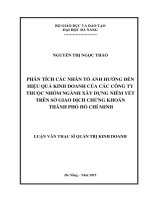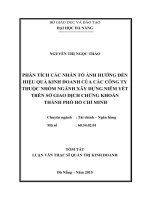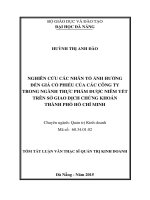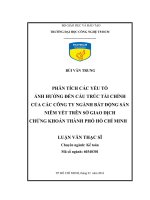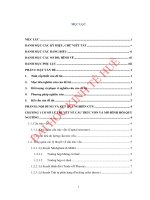Screening of turmeric germplasm for resistance to rhizome rot - TRƯỜNG CÁN BỘ QUẢN LÝ GIÁO DỤC THÀNH PHỐ HỒ CHÍ MINH
Bạn đang xem bản rút gọn của tài liệu. Xem và tải ngay bản đầy đủ của tài liệu tại đây (157.6 KB, 7 trang )
<span class='text_page_counter'>(1)</span><div class='page_container' data-page=1>
<i><b>Int.J.Curr.Microbiol.App.Sci </b></i><b>(2017)</b><i><b> 6</b></i><b>(11): 2518-2526 </b>
2518
<b>Original Research Article </b>
<b>Screening of Turmeric Germplasm for Resistance to Rhizome Rot </b>
<b>M. Lakshmi Naga Nandini1*, C.H. Ruth1 and K. Gopal2</b>
1
Department of Plant Pathology, College of Horticulture, Dr. YSRHU,
Anantharajupeta- 516105, Andhra Pradesh, India
2
Department of Plant Pathology, Dr. YSRHU, Venkataramannagudem-534101,
Andhra Pradesh, India
<i>*Corresponding author </i>
<i><b> </b></i> <i><b> </b></i><b>A B S T R A C T </b>
<i><b> </b></i>
<b>Introduction </b>
Turmeric (<i>Curcuma longa</i> L.) is an important
spice crop of India and all over the world. It
plays a significant role in earning valuable
foreign exchange. India is the world’s largest
producer and exporter of turmeric which
accounts for 80 per cent of the international
trade followed by China, Myanmar and
Bangladesh (Satishkumar, 2005). It is used in
medicine as a carminative and antibiotic as an
effective cure for several diseases. Besides,
the use of turmeric colouring pigment
(curcumin) and volatile oil (tumerol) in
various food and drink items has increased its
economic importance in the global market.
Turmeric is vulnerable to a number of fungal
diseases of both soil and air borne nature.
Rhizome rot of turmeric caused by <i>Pythium </i>
<i>aphanidermatum</i> is a major constrain for the
production of healthy rhizome (Fig. 1)
(Rathiah, 1987, Nageshwar Rao, 1994,
Ramarethinam and Rajagopal, 1999).
Chemical control of this pathogen is not
practical because of high cost of chemicals,
occasional break down of resistance,
environmental pollution, deleterious effect to
non-target beneficial soil micro-organism and
ultimately the choice of the consumer for an
organic product (Pandey <i>et al.,</i> 2010). Hence,
development of resistant varieties and their
incorporation in IDM schedule is a viable
alternative for management of this pathogen.
College of Horticulture, Anantharajupeta,
<i>International Journal of Current Microbiology and Applied Sciences </i>
<i><b>ISSN: 2319-7706</b></i><b> Volume 6 Number 11 (2017) pp. 2518-2526 </b>
Journal homepage:
Thirty varieties of turmeric <i>Curcuma longa</i> L. were screened in the field
against <i>Pythium aphanidermatum </i>for one year during 2016-2017 at College
of Horticulture, Anantharajupeta, Y.S.R. Kadapa, Andhra Pradesh. These
varieties were also screened in lab and net house (pot) condition. Out of 30
varieties two varieties (Salem and Prathibha) showed resistance to rhizome
rot and five (TCP-129, VK-9, IC-330113, IC-033007 and IC-212606) were
moderately resistant, providing good material for developing rhizome rot
resistant turmeric varieties.
<b>K e y w o r d s </b>
Turmeric, Rhizome
rot, <i>Pythium </i>
<i>aphanidermatum</i>,
Germplasm, Resistant.
<i><b>Accepted: </b></i>
20 September 2017
<i><b>Available Online:</b></i>
10 November 2017
</div>
<span class='text_page_counter'>(2)</span><div class='page_container' data-page=2>
<i><b>Int.J.Curr.Microbiol.App.Sci </b></i><b>(2017)</b><i><b> 6</b></i><b>(11): 2518-2526 </b>
2519
Y.S.R. Kadapa, A.P. maintains a large
collection of turmeric from Kerala, Himachal
Pradesh and West Bengal, in the germplasm
conservatory, offering great scope for
identification of resistant sources. Keeping
the above in view, the available 30 turmeric
varieties were evaluated for their
resistance/susceptibility. The main objective
was to screen in more controlled and tested
conditions by using proper standard inocula in
artificial methods in triplicate to get authentic
result. Standard scoring method was followed
to identifying the disease reactions in all the
conditions with a comparative analysis.
<b>Materials and Methods </b>
<b>Standardization of inoculum density</b>
The mycelia suspension of the <i>P. </i>
<i>aphanidermatum </i>was prepared by harvesting
the mycelia mats from a 7 day old culture
raised on potato dextrose broth. The mats
were homogenized in a blender for 1 min and
strained through double layered muslin cloth
and diluted with sterile distilled water so as to
contain 15-20 mycelial bits per microscopic
field. The inoculum was added to 45 days old
healthy plants raised in sterilized pots, at 2, 4,
6, 8, 10 and 12 %. Healthy plant was
maintained as control. Three replications were
set for each treatment. The percentage of
disease incidence and that of rhizome rot
incidence were recorded (Table 1).
<b>Screening of turmeric germplasm under </b>
<b>field conditions </b>
Screening of 30 turmeric varieties against the
rhizome rot was carried out for one year
during 2016–2017 at College of Horticulture
(COH), Anantharajupeta (Kadapa, A.P.,
India) located at 13o99'0" N and 79o33'0" E.
Screening was done at different time intervals
in 2016-17 particularly from the month of
September to December. Planting was done in
the month of April–May 2016-17. Selected
sample material was harvested and collected
in the month of March–April in the respective
year for further investigation. The experiment
was laid out in a randomized block design
(RBD) with three replications (Plot size = 3 m
x 3 m). Germination percentage counts at 45
days after planting (DAP) and percentage of
rhizome rot incidence at 150 DAP, at harvest
were performed. Finally on the basis of
percent disease incidence (PDI) the
germplasms were screened and categorically
grouped into different types of reactions as
follows.
<b>Screening of turmeric germplasm under </b>
<b>laboratory conditions </b>
</div>
<span class='text_page_counter'>(3)</span><div class='page_container' data-page=3>
<i><b>Int.J.Curr.Microbiol.App.Sci </b></i><b>(2017)</b><i><b> 6</b></i><b>(11): 2518-2526 </b>
2520
considered as pathogenic. Such fungi were
re-isolated on PDA slants from the artificially
infected rotten rhizomes and studied for
confirmation of the identity of the organism
inoculated in each case. The isolates of test
fungi namely, <i>Pythium aphinidermatum</i> were
raised on PDA in petri-plates for securing
fungal discs for experimental purposes. In
another set, petri dishes were sterilized after
making a cross mark on the lower lid for
indicating its centre. Antibiotic rich PDA was
prepared. The required dose of chemical (s)
for each treatment was weighed separately,
suspensions of these chemicals in sterile
water were incorporated into the medium.
<b>Screening of turmeric germplasm under </b>
<b>green house condition </b>
Earthen pots (30 cm in diameter) containing
sterile soil mixed up thoroughly with fungal
mass culture (one flask for each pot) and
incubated for 7 days being covered with black
polythene sheet. After incubation rhizome of
turmeric were planted in the pot.
After emergence of sprouting, the inoculum
was grown in sand maize meal and was
inoculated in potted plant. Watering was done
to maintain proper moisture level. After
emergence of sprout from the turmeric, close
observation was kept for 45 days.
<b>Statistical analysis </b>
The data thus obtained was subjected to
statistical analysis using PAST (Hammer <i>et </i>
<i>al.,</i> 2001). The mean and standard deviation
of disease incidence percent in each variety
was taken for calculating pathogen
susceptibility ratings.
<b>Results and Discussion </b>
Out of all the turmeric cultivars screened
under field conditions Prathibha, Salem,
PTS-8, CL-10, NB-60, IC-033007, IC-211641,
Kasturi, ACC-79 were resistant to rhizome
rot, showed 0.0 % diseases incidence,
whereas BSR-2 (08.37%), TCP-64 (10.00%),
TCP-70 (08.12%), TCP-129 (08.00%),
NDH-8 (05.26%), IC-330113 (04.36%), IC-212606
(08.37%), IC-211647 (07.91%) were
moderately resistant to the pathogen (Table
4). Rajendra Sonia (37.00%), KTS-6
(22.58%), KTS-7 (33.00%) and Gl- Puram
(28.76%) were susceptible to rhizome rot
whereas RH-9/90 (62.50%) was highly
susceptible. CL-12 (12.97%), IC-416941
(12.76%), Morthapuzta (11.76%), Roma
(13.79%), CL-1 (16.66%), VK-9 (11.42%),
Sports (15.62%) and CLI-335 (18.75%) were
moderately susceptible to rhizome rot.
</div>
<span class='text_page_counter'>(4)</span><div class='page_container' data-page=4>
<i><b>Int.J.Curr.Microbiol.App.Sci </b></i><b>(2017)</b><i><b> 6</b></i><b>(11): 2518-2526 </b>
2521
<b>Table.1 </b>Standardization of inoculum density for artificial inoculation
<b>Sl. no. </b> <b>Percent inoculum Level Percent disease incidence Percent </b> <b>rhizome rot </b>
1 0 0.00 0.00
2 2 15.00 20.20
3 4 22.33 25.44
4 6 32.44 42.22
5 8 72.66 80.16
6 10 100.00 100.00
7 12 100.00 100.00
S.Em (±) 0.304
CD at 1 % 0.815
<b>Table.2 </b>Rhizome rot reaction in laboratory conditions of turmeric germplasms
in Andhra Pradesh
<b>Sl. no. </b> <b>Name of the Germplasm </b> <b>Rotting %in the laboratory (M ± SE) Disease Reaction </b>
1. Rajendra Sonia 60 ± 0.45 S
2. Prathibha 0 ±0 R
3. Morthapuzta 60 ± 0.51 S
4. Salem 0 ±0 R
5. KTS-6 60 ± 0.15 S
6. KTS-7 30 ± 2.08 MS
7. BSR-2 70 ± 0.26 S
8. TCP-64 70 ± 0. 27 S
9. TCP-70 60 ± 0.43 S
10. TCP-129 30 ± 0.37 MS
11. PTS-8 40 ± 0.32 MS
12. Roma 90 ± 0.2 HS
13. CL-1 70 ± 1.5 S
14. CL-10 70 ± 0.15 S
15. VK-9 5 ± 0.12 MR
16. RH-9/90 60 ± 0.43 S
17. NB-60 60± 0.37 S
18. NDH-8 80 ± 0.26 HS
19. Sports 30 ± 0.37 MS
20. CLI-335 80 ± 0.2 HS
21. Gl-Puram 30 ± 0.32 MS
22. Kasturi 60 ± 0.43 S
23. ACC-79 60 ± 0.26 S
24. IC-416941 70 ± 0.26 S
25. IC-330113 9 ± 0.21 MR
26. IC-033007 6 ± 0.35 MR
27. IC-212606 20 ± 11.11 MR
28. IC-211647 70 ± 0.15 S
29. IC-211641 70 ± 0.26 S
</div>
<span class='text_page_counter'>(5)</span><div class='page_container' data-page=5>
<i><b>Int.J.Curr.Microbiol.App.Sci </b></i><b>(2017)</b><i><b> 6</b></i><b>(11): 2518-2526 </b>
2522
<b>Table.3 </b>Rhizome rot reaction in nethouse conditions of turmeric germplasms in Andhra Pradesh
<b>Sl. no. </b> <b>Name of the germplasm </b> <b>% of infection </b> <b>Disease reaction </b>
1. Rajendra Sonia 80 ± 19.24 HS
2. Prathibha 0 ±0 R
3. Morthapuzta 80 ± 11.11 HS
4. Salem 0 ±0 R
5. KTS-6 100 ±0 HS
6. KTS-7 20 ± 11.11 MR
7. BSR-2 80 ± 19.24 HS
8. TCP-64 80 ± 22.22 HS
9. TCP-70 50 ± 11.11 MS
10. TCP-129 20 ± 11.11 MR
11. PTS-8 50 ±0 MS
12. Roma 100 ±0 HS
13. CL-1 100 ±0 HS
14. CL-10 100 ±0 HS
15. VK-9 20 ± 11.11 MR
16. RH-9/90 64.42 ± 0.28 HS
17. NB-60 80 ± 11.11 HS
18. NDH-8 100 ±0 HS
19. Sports 06.25 ± 0.02 MR
20. CLI-335 64.42 ± 0.28 HS
21. Gl-Puram 55.00 ± 0.57 HS
22. Kasturi 37.00 ± 0.57 S
23. ACC-79 33.00 ± 0.57 S
24. IC-416941 62.50 ± 0.12 HS
25. IC-330113 10.00 ± 0.57 MR
26. IC-033007 50 ±0 MS
27. IC-212606 08.12 ± 0.11 MR
28. IC-211647 55.00 ± 0.57 HS
29. IC-211641 28.76 ± 0.1 S
</div>
<span class='text_page_counter'>(6)</span><div class='page_container' data-page=6>
<i><b>Int.J.Curr.Microbiol.App.Sci </b></i><b>(2017)</b><i><b> 6</b></i><b>(11): 2518-2526 </b>
2523
<b>Table.4 </b>Rhizome rot reaction and yield parameter in natural field condition of turmeric
germplasms in Andhra Pradesh
<b>Sl. </b>
<b>no. </b>
<b>Name of the </b>
<b>Germplasm </b>
<b>Germination </b>
<b>(%) </b>
<b>(M ± SE) </b>
<b>Percent disease </b>
<b>incidence (%) </b>
<b>(M ± SE) </b>
<b>Yield (kg/plot) </b>
<b>(M ± SE) </b>
<b>Reaction </b>
<b>category </b>
1. Rajendra Sonia 80.00 ± 0.57 37.00 ± 0.57 18.74 ± 1.29 S
2. Prathibha 95.00 ± 0.57 00.00 ± 0 12.30 ± 0.1 R
3. Morthapuzta 85.00 ± 1 11.76 ± 0.68 7.44 ± 0.67 MS
4. Salem 65.00 ± 0.57 00.00 ± 0 9.50 ± 0.56 R
5. KTS-6 77.50 ± 0.52 22.58 ± 0.04 14.00 ± 2.78 S
6. KTS-7 90.00 ± 0.57 33.00 ± 0.57 6.50 ± 2.37 S
7. BSR-2 87.50 ± 0.57 08.37 ± 0.07 42.30 ± 0.36 MR
8. TCP-64 70.00 ± 0.57 10.00 ± 0.57 12.00 ± 0.8 MR
9. TCP-70 85.00 ± 0.57 08.12 ± 0.11 15.80 ± 0.79 MR
10. TCP-129 67.50 ± 0.33 08.00 ± 0.57 14.50 ± 0.48 MR
11. PTS-8 92.50 ± 0.65 00.00 ± 0 15.48 ± 0.17 R
12. Roma 72.50 ± 0.57 13.79 ± 0.09 6.00 ± 0.37 MS
13. CL-1 80.00 ± 0.57 16.66 ± 0.13 22.00 ± 0.33 MS
14. CL-10 82.50 ± 1. 67 00.00 ± 0 17.84 ± 0.26 R
15. VK-9 87.50 ± 0.09 11.42 ± 0.19 9.40 ± 1.6 MS
16. RH-9/90 80.00 ± 0.57 62.50 ± 0.12 16.00 ± 1.64 HS
17. NB-60 83.33 ± 0.54 00.00 ± 0 5.76 ± 0.27 R
18. NDH-8 95.00 ± 0.57 05.26 ± 0.08 7.22 ± 0.22 MR
19. Sports 80.00 ± 0.57 15.62 ± 0.49 12.90 ± 0.69 MS
20. CLI-335 80.00 ± 0.83 18.75 ± 0.04 8.50 ± 1.31 MS
21. Gl-Puram 84.00 ± 0.57 28.76 ± 0.1 14.40 ± 2.23 S
22. Kasturi 88.00 ± 0.57 00.00 ± 0 22.50 ± 0.08 R
23. ACC-79 78.50 ± 1.49 00.00 ± 0 18.47 ± 0.14 R
24. IC-416941 88.00 ± 1.76 12.76 ± 0.38 9.42 ± 0.56 MS
25. IC-330113 89.00 ± 0.46 04.36 ± 0.09 9.82 ± 0.33 MR
26. IC-033007 63.38 ± 0.74 00.00 ± 0 6.76 ± 0.97 R
27. IC-212606 87.50 ± 0.57 08.37 ± 0.07 42.30 ± 0.36 MR
28. IC-211647 67.50 ± 0.42 07.91 ± 0.08 22.60 ± 0.80 MR
29. IC-211641 78.00 ± 0.32 00.00 ± 0 20.53 ± 0.17 R
</div>
<span class='text_page_counter'>(7)</span><div class='page_container' data-page=7>
<i><b>Int.J.Curr.Microbiol.App.Sci </b></i><b>(2017)</b><i><b> 6</b></i><b>(11): 2518-2526 </b>
2524
<b>Table.5 </b>Comparative study on disease reaction data from field in natural condition, data from
storage infection and data from inoculation of pathogen in pot culture
<b>Sl.No </b> <b>Name of the </b>
<b>germplasm </b>
<b>Disease </b>
<b>reaction in </b>
<b>field </b>
<b>Disease reaction </b>
<b>in storage </b>
<b>incubation </b>
<b>Disease </b>
<b>reaction in pot </b>
<b>inoculation </b>
<b>Overall </b>
<b>disease </b>
<b>reaction </b>
1. Rajendra Sonia S S HS S
2. Prathibha R R R R
3. Morthapuzta MS S HS S
4. Salem R R R R
5. KTS-6 S S HS S
6. KTS-7 S MS MR MS
7. BSR-2 MR S HS S
8. TCP-64 MR S HS S
9. TCP-70 MR S MS MS
10. TCP-129 MR MS MR MR
11. PTS-8 R MS MS MS
12. Roma MS HS HS HS
13. CL-1 MS S HS S
14. CL-10 R S HS S
15. VK-9 MS MR MR MR
16. RH-9/90 HS S HS HS
17. NB-60 R S HS S
18. NDH-8 MR HS HS HS
19. Sports MS MS MR MS
20. CLI-335 MS HS HS HS
21. Gl-Puram S MS HS S
22. Kasturi R S S S
23. ACC-79 R S S S
24. IC-416941 MS S HS S
25. IC-330113 MR MR MR MR
26. IC-033007 R MR MS MR
27. IC-212606 MR MR MR MR
28. IC-211647 MR S HS S
29. IC-211641 R S S S
30. CL-12 MS HS HS HS
<b>Screening of Turmeric Germplasm under Field Conditions</b>
<b>Scoring scale </b> <b>Percent disease incidence </b> <b>Reaction </b>
1 0 Resistant (R)
2 1-10 Tolerant/Moderately resistant (MR)
3 11-25 Moderately susceptible (MS)
4 26-50 Susceptible (S)
</div>
<!--links-->
luận văn thạc sĩ các yếu tốt quyết định đến kết quả học tập môn toán của học sinh lớp 10 so sánh khu vực đô thị với khu vực nông thôn thành phố hồ chí minh
- 128
- 640
- 0
